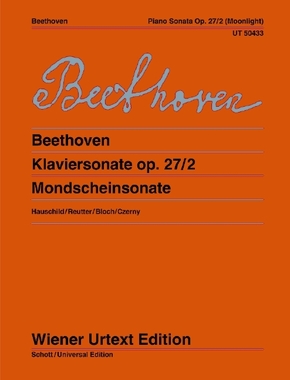Klaviersonate (Mondscheinsonate) - Neuausgabe. op. 27/2. Klavier.
| Verlag | Schott Music |
| Auflage | 2019 |
| Format | 8,4 x 30,3 x 0,3 cm |
| Noten | Urtextausgabe (Rückendrahtheftung) | |
| Gewicht | 132 g |
| Reihe | Wiener Urtext Edition |
| ISBN-10 | 3850557952 |
| ISBN-13 | 9783850557955 |
| Bestell-Nr | 85055795A |
Sie ist wohl die bekannteste aller Klaviersonaten Beethovens - die sog. Mondscheinsonate, und man sollte glauben, dass zu diesem Werk bereits alles gesagt sei. Doch keineswegs! Auch sie zeigt Probleme im überlieferten Notentext, denen die Neuausgabe noch einmal akribisch auf den Grund geht.Besetzung:Klavierop. 27/2
Sie ist wohl die bekannteste aller Klaviersonaten Beethovens - die sog. Mondscheinsonate, und man sollte glauben, dass zu diesem Werk bereits alles gesagt sei. Doch keineswegs! Auch sie zeigt Probleme im überlieferten Notentext, denen die Neuausgabe noch einmal akribisch auf den Grund geht. Ist es in Takt 159 des 3. Satzes etwa ein Notenkopf oder ein Staccato? Diese und andere Fragen werden in der Edition geklärt und in den Kritischen Anmerkungen plausibel begründet. Die Ausgabe enthält ferner aufführungspraktische Bemerkungen von Beethovens Schüler Carl Czerny, die u.a. in die poetische Gedankenwelt einführen, die hinter dem Werk steht und einer fantasievollen Interpretation wesentliche Impulse vermittelt.Schwierigkeitsgrad: 5
The "Moonlight Sonata" is probably the best known of all of Beethoven's piano sonatas, and one should think that all that can be said about this work has already been said. But far from it! Even this sonata shows problems in the surviving musical text into which this new edition looks very meticulously.Besetzung:pianoop. 27/2
The so-called Moonlight Sonata is probably the best known of all of Beethoven's piano sonatas, and one should think that all that can be said about this work has already been said. But far from it! Even this sonata shows problems in the surviving musical text into which the new edition looks very meticulously. Is it a note-head or a staccato dot in bar 159 of the 3rd movement? This and other questions are answered in the edition and reasonably explained in the Critical Notes. Furthermore, the edition contains remarks of Beethoven's pupil Carl Czerny concerning the performance practice which introduce us into the poetic way of thinking, among others, that is behind the work and provides an essential impetus to a highly imaginative interpretation.Instrumentation:pianoop. 27/2

